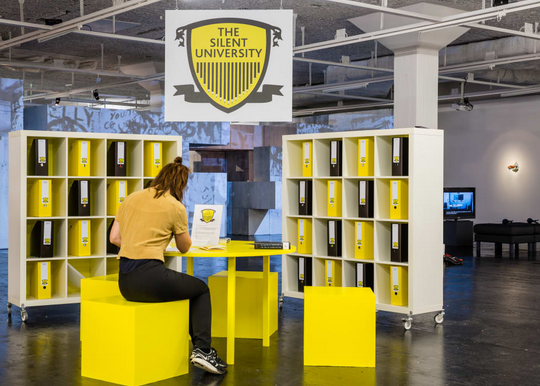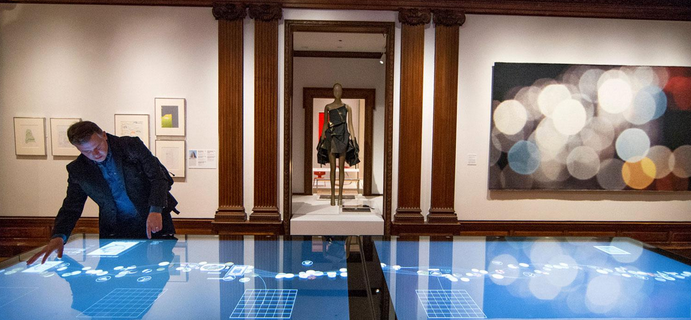The Museum as Think-Tank: The Role of the Museum in the 21st Century
Art is an integral part of a contemporary art museum. As Hans Ulrich Obrist often says “curating follows art.” But, the museum is not only a venue to collect, store, and present artistic ideas and their commentary it is also stage for synthesis and a venue for collaboration – a think-tank in constant flux.
 Installation view of the entrance to Hon: en katedral (She: A Cathedral), 1966. Photograph by Hans Hammarskiöld. Courtesy of the Moderna Museet and Hans Hammarskiöld.
Installation view of the entrance to Hon: en katedral (She: A Cathedral), 1966. Photograph by Hans Hammarskiöld. Courtesy of the Moderna Museet and Hans Hammarskiöld.
I propose to ask a different question not what is the role but instead what role should the contemporary arts institution have? In my opinion a contemporary arts institution should cater to its community, introducing new ideas to offer its visitors valuable insight to reflect on the past and present. The Swedish curator Pontus Hultén asked himself this question and many others when he curated controversial exhibitions that challenged the presiding bourgeois taste. His career is marked by collaborations between institutions and individuals. Visitors were shocked when they were made to enter the exhibition ‘She: A Cathedral'(1966) through the parted legs of Niki de Saint Phalle’s site specific sculpture of a pregnant female. The exhibition itself was a critique of pop art including works by Niki de Saint Phalle, Jean Tingeuly, and Per Olov Ultveldt. In 1974, Centre Pompidou was ideated as a multicultural complex, grounded in André Malraux’s ideas, to decentralize and democratize art. In its first years, the art museums founding director Pontus Hultèn’s curatorial program consisted of interdisciplinary investigations offering new perspectives on the history of modern art. This moment of institutional self-reflection was supported and developed by artists engaged in creating work of institutional critique or those who questioned the need for museums entirely, such as Marcel Broodthaers, Hans Haacke, Lygia Pape, and Martha Rosler. These practices have shaped current museology practice that recognizes the importance of making art available beyond exhibitions. Now museums realize their mission through public and educational programs, scholarship, and events in addition to producing exhibitions, and maintaining their collection.
 Ahmet Ögüt, The Silent University. Tensta konsthall, 2013 Photograph by Jean-Baptiste Beranger. Courtesy of Mynewsdesk.
Ahmet Ögüt, The Silent University. Tensta konsthall, 2013 Photograph by Jean-Baptiste Beranger. Courtesy of Mynewsdesk.
Today, we must ask ourselves how these legacies can be further developed adapting tp the 21st century. Discerning between the needs of a local and global community and catering to the separate needs of visitors can invigorate museum programming. Maria Lind, director of Tensta Konsthall, attempts to engage their universal audience with the local community, which is dominated by low-income and multicultural residents on one hand by presenting and commissioning art by international artists working with displacement, immigration, sexuality, and other themes that might provide fertile ground for thought connecting to pressing local issues. One example is The Silent University, a project offering lectures and classes geared towards migrants and refugees created by Turkish artist Ahmet Ögüt in collaboration with several other institutions across Europe. On the other, Tensta Konsthall actively seeks out local partners to collaborate with in different ways ranging from offering their spaces for religious or political meetings, workshops on humanitarian journalism for youth, to free entrance for residents. Under Lind’s directorship the art center is both a venue for exhibiting art and a community center that offers socially engaged activities, for local and global visitors.
 The New Cooper Hewitt Experience includes touch screens and a pen that allows visitors to save works digitally. Courtesy of Digital Trends.
The New Cooper Hewitt Experience includes touch screens and a pen that allows visitors to save works digitally. Courtesy of Digital Trends.
Technology is another avenue that is changing the museum. Only the tip of the iceberg, digitized collections have made rarely seen work available to the public adding virtual visitors to the museums rooster of audience members. Digital publications, exhibitions, apps to enhance museum-goers experiences during and after visits, data collection, and more has followed. The New Museum, especially Lauren Cornell through Rhizome, has made headway into how digital art can become a stand-alone element of the museum online. Museums must continue to reserve funding for technology in order to develop its potential.
institutions of higher education are seeing the potential benefits of curators giving back to academia
The cult of the curator and the increase of specialized programs relating to museum work at institutions for higher learning has resulted in a collapse of the museum and the academic institution. At my own institution, Bard Graduate Center, Elissa Auther is both a curator at Museum of Arts and Design and a part-time professor, She uses her seminars to teach but also to develop her research and curatorial projects together with students. Lauren Cornell was recently appointed the Director of Graduate Program at CCS Bard Center for Curaotrial Studies and Chief Curator of the Hessel Museum of Art. Maria Lind served as the director of the Graduate Program at CCS Bard (2008-2010). Students and researchers have long made use of the museum as a resource but these appointments show that institutions of higher learning are seeing the potential benefits of curators giving back to academia.
Returning to my opening statement, thinking about the museum as a think tank in flux where art is an integral part but not the core. The core of the museum, those who allow for its growth and experimentation, are its staff, its visitors, and partners. Like the ever evolving ideas of a think tank, the museum must adapt to the increased sophistication of its audience nad partners by anticipating and exceeding their needs in new ways.
What's Your Reaction?
Anna Mikaela Ekstrand is editor-in-chief and founder of Cultbytes. She mediates art through writing, curating, and lecturing. Her latest books are Assuming Asymmetries: Conversations on Curating Public Art Projects of the 1980s and 1990s and Curating Beyond the Mainstream. Send your inquiries, tips, and pitches to info@cultbytes.com.

